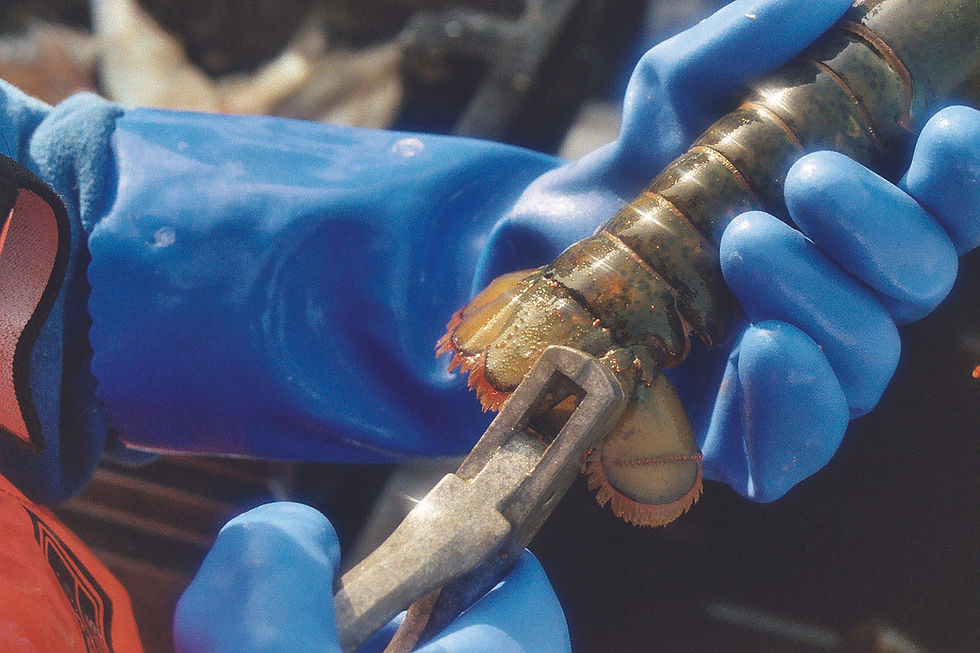To Pay It Foward: Lobstermen V-Notch
- Jarod Bray

- Jul 30
- 3 min read
By Jarod Bray, MLA Board Chair and
Dustin Delano, NEFSA Chief Operating Officer
Maine’s lobster fishery is one of the most sustainable in the world and that’s no accident. For generations, lobstermen have led conservation in the Gulf of Maine, and we must remain committed to maintaining our proud legacy of environmental stewardship.

Lobstermen advocated to make V-notching mandatory in 2002. Visit www.vnotch.info for more information. Photo by K. Reardon.
This summer, our organizations, the Maine Lobstermen’s Association (MLA) and the New England Fishermen’s Stewardship Association (NEFSA), are working together to promote one of the most effective, uniquely Maine, conservation practices: V-notching.
V-notching is simple but powerful. When a lobsterman catches a female lobster bearing eggs, they carve a small, harmless mark in the right tail flipper. This V-notch identifies her as a reproductive female. She is then carefully returned to the ocean so she can continue to reproduce after her eggs have hatched.
Just as you save for your own future, V-notching is an investment in our fishery’s future. Maintaining a robust number of reproductive females is essential to ensure there are lobsters to catch in the future. While a single female can produce thousands of eggs, less than one percent of eggs survive to become a legal lobster. V-notched lobsters produce nine times more eggs than unnotched ones and may increase the spawning biomass by up to 632 percent.
It is no surprise that a 2009 MLA survey found that 90 percent of lobstermen who responded considered V-notching a “very effective” conservation practice.
Marking egg-bearing females in Maine began in 1917, with modern V-notching becoming standard around 1975. Maine lobstermen have long pushed for common sense, pro-sustainability regulations. V-notching evolved as a voluntary practice and it was industry advocacy that prompted regulators to make it mandatory in 2002, creating the strictest “zero tolerance” V-notch law in the United States.
One lobsterman beautifully captured the attitude in a 2018 study. “I can remember in the ‘90s again, you [caught] a female loaded down with eggs and it was almost a reverent moment. You took the time. My grandfather would practically stop the boat and put a huge notch in it and cradle it back into the water.”
Today’s lobstermen benefit from the efforts of their forebearers. For nearly two decades, Maine’s lobster fishery has thrived, with record high landings and a healthy resource. It proves conservation is good business.
A 2018 study showed that Maine’s conservation practices expanded the growth of the Gulf of Maine lobster population and suggested that Southern New England’s lobster stock crash would have been far less severe if it had these same practices in place.
It’s critical that all Maine lobstermen remember that their success is, in large part, the result of those who V-notched lobsters before, and they must continue the practice to pay it forward.
As favorable ecosystem conditions shift and regulatory pressures grow, the future of the lobster industry is less certain. The industry successfully pushed back against increasing the legal size of lobsters and, thanks to Maine’s Congressional delegation and Governor, avoided unfair and burdensome right whale regulations that would have dismantled the fishery.
The industry’s voice is being heard, but that credibility depends on continuing the conservation ethic that built it.
Fishermen rightfully advocate for a greater voice in management decisions. Maintaining credibility in the regulatory process depends on lobstermen continuing to live up to our reputation as world-class stewards of the lobster resource. The future of Maine’s lobster fishery depends on it.



Comments